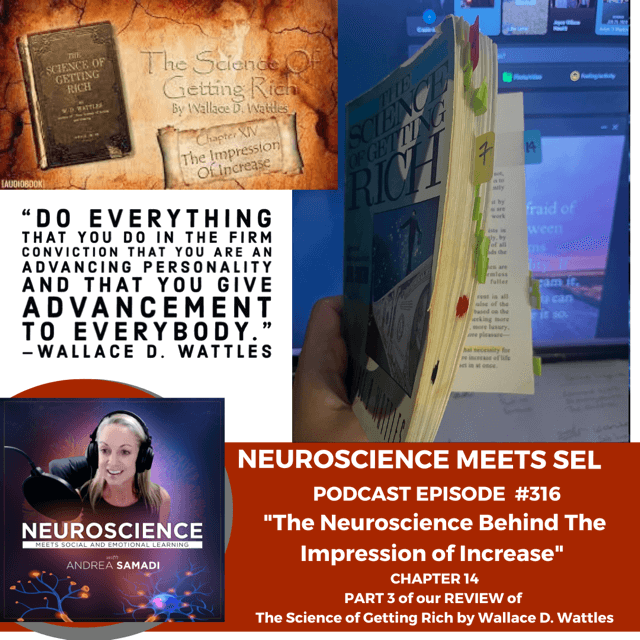“We don’t have to engage in grand, heroic actions to participate in the process of change. Small acts, when multiplied by millions, can transform the world.” Howard Zinn

On today's episode #316 and PART 3 of our REVIEW of Wallace D. Wattles The Science of Getting Rich, we will cover:
✔ REVIEW PART 1: Prosperity Thinking vs Poverty Thinking.
✔ Why are our thoughts so important for our results?
✔ Why are Chapters 4/14/7 important chapters for unlocking the "secrets" for wealth and abundance?
✔ Why must we THINK and ACT in a Certain Way to achieve certain results in our life?
✔ What is the Impression of Increase?
✔ What does Neuroscience have to do with this age-old success principle?
✔ 2 TIPS for practicing The Impression of Increase with EVERYONE you interact with.
“Increase is what all men and women are seeking: it is the urge of the Formless Intelligence within them, seeking fuller expression…All human activities are based on this desire for increase; people are seeking more food, more clothes, better shelter, more luxury, more beauty, more knowledge, more pleasure—increase in something, more in life.” Wallace D. Wattles, The Science of Getting Rich

Welcome back to The Neuroscience Meets Social and Emotional Learning Podcast, where we connect the science-based evidence behind social and emotional learning (that’s finally being taught in our schools today) and emotional intelligence training (used in our modern workplaces) for improved well-being, achievement, productivity and results—using what I saw as the missing link (since we weren’t taught this when we were growing up in school), the application of practical neuroscience. I’m Andrea Samadi, an author, and an educator with a passion for learning and launched this podcast 5 years ago with the goal of bringing ALL the leading experts together (in one place) to uncover the most current research that would back up how the brain.
Which brings us to chapter 14 of Wallace D. Wattles’ The Science of Getting Rich, published in 1910 on “The Impression of Increase.” This is one of my favorite chapters, and one I know that my mentor Bob Proctor LOVED practicing The Impression of Increase. Brian Proctor talked about this on our recent interview EP 292[i] this past summer. Brian covers this topic beautifully in his book, My Father Knew the Secret, in the 2nd last chapter on “Supporting Others.”
Bob Proctor would practice this principal from Chapter 14 and say to “leave everyone you meet with The Impression of Increase” and I remember when I first began to study this chapter, I wrote in BIG LETTERS at the top of the page to “take the focus off yourself and put it on other people.” Then I circled in the notes section “go out and LOOK for an opportunity to help others.”

Now this seems simple enough, right? We talked about the importance of understanding how Giver’s Gain in PART 1[ii] of this study.
While I can easily go off on tangents while writing these reviews, I want to stick to how Wallace D. Wattles wrote about this concept FIRST, and then add in ways that I’ve seen others implements this idea.
Wattles opens up Chapter 14 by saying “whether you change your vocation or not, you must direct your present actions to the business you are presently engaged” and he goes on to say that “you can get into the business you want by making constructive use of the business you are already established in—by doing your work in this certain way.”
The next few lines I highlighted. He says “And, in so far as your business consists in dealing with other people—whether directly, by telephone, or by letter (yes, this book was written in 1910!), the key thoughts to all your efforts must be to convey to their minds the impression of increase.” (Chapter 14, Wattles, SGR).
Remember there is an order to “unlocking the combination for success and wealth” in this book, and that’s to read Chapters 4/14 and 7 in this order for 90 days. I’m hoping to complete our review of these 3 chapters before the holidays here in the US, and will return in the New Year, adding in the final chapters of this book. If you’ve listened to PART 1[iii] of our review, you’ve seen the importance of opening up our minds to prosperity thinking, (that there is more than enough for all of us vs poverty consciousness that there is not enough) and PART 2[iv] we focused on the power of our thoughts, specifically with how to “think and act in this certain way” to achieve the results we are talking about here. We gave examples of two distinct types of thinkers, encouraging all of us to open the keyhole in the door (or kick in the door) and expand of level of awareness in this process. Today, in PART 3 of our review, we will explore Chapter 14, on The Impression of Increase, and PART 4, will cover Chapter 7 on Gratitude. If we ONLY read these 3 chapters for 90 days, I can guarantee you would see incredible change in your daily life. Doing things in this certain way will not only change your day to day life, but will put all of us ALL in the right mindset for an incredible 2024. In the New Year, we will add in the final chapters to bring the complete meaning of this book to life.
PUTTING THE IMPRESSION OF INCREASE INTO ACTION:
So how do we take this concept and put it into action in our daily lives? It’s all about taking the focus off ourselves, and directing it towards others. Since all people seek this increase, if we become someone who inherently gives this to others, we will become in demand.
Wattles tells us to “Convey the impression of advancement with everything you do, so that all people will receive the impression that you are an advancing person and that you advance all who deal with you. Also, give people who you meet socially the thought of increase.”
What if we are completely unhappy with where we are currently (our work or our lives in some way) and it’s REALLY difficult to look outside of ourselves and put the focus onto others?
Wattles says this is the key to this chapter when he opens Chapter 14 up by saying “whether you change your vocation or not, you must direct your present actions to the business you are presently engaged.” The opening to Chapter 14 has helped me through many difficult work and life challenges. It’s always easy when you are unhappy with something to think that somewhere else will be better, (it’s possible it might be, since we all seek increase so don’t ignore that feeling of wanting more in life) but to get to this increase, we’ve got to work very hard in our current situation to convey this impression of increase and this begins with having this mental attitude, or living The Impression of Increase.
“Do everything that we do with with the firm conviction that you are an advancing personality, and that you are giving advancement to everybody.” (Wattles, Chapter 14, SGR).
Do your daily work in this CERTAIN way, giving The Impression of Increase to others with everything that you do.
Don’t give up with what you are doing (even if you are tempted to) but find the energy to give and do more in your line of work, and watch what happens.
If you are a student, study with everything that you’ve got. Study your mind first, then look to see who else you can assist.
If you are an athlete, train to perfect your skills. Train your body first, then look to your teammates to see how you can assist them.
If you are in sales, work hard to sell more. Fill your own pipeline first, then look to see who else needs your help.
Build your own skills first, and I’ve got to tie in what Stanford Professor Dr. Andrew Huberman would say on this topic to tie in the science here. He would encourage us to face “the initial stage of hard work that involves agitation, stress and confusion”[v] in the beginning of reaching for a new goal. Ask anyone who has started from the beginning, this is exactly what they must go through to hit their targets. Think of an athlete here who must do the hard training day in and day out, to hit their goals. During this process, be sure that you are “willing to set your goals a bit above what you believe at this time, that you can accomplish” (Dr. Huberman).
Then take the focus off of yourself, and see who else you can help around you. That’s Living the Impression of Increase, starting with yourself first, and then helping others to do the same.
IMPRESSION OF INCREASE ACTIVITY: RAISING UP OTHERS AND CHANGING THE WORLD IN THE PROCESS:
Remember that it takes just small actions to make a huge impact in the world. We don’t need to give large gifts, (you can but it’s not the size of the deed that matters).
TRY THIS ACTIVITY: Write down the names of 3 people you know who could use your help in some way, and reach out to them for a brainstorming session to see who you know that could help them with where they are going.
- Ask them: What do you need? How can I help you?
- Then think of who you know that can help them to get what they need.
With every person we interact with think about how we can assist them in some way. How can we put The Impression of Increase into action?
OTHER IDEAS: I learned these from working with Bob Proctor for 6 years. He undeniably practiced this concept with EVERY PERSON he interacted with, and after watching him to do over the years, and reading this book, I noticed that I do make an effort to live The Impression of Increase.

Here’s 2 TIPS to keep at the forefront of your mind in every interaction you have with someone to put The Impression of Increase into practice.
- Give others genuine compliments and point out their accomplishments and efforts. You have to mean this, it can’t be false compliments or it will be obvious that you are not being sincere. You must REALLY want to see someone advance, believe and know that they can, and when you tell them what you see, it will encourage them want to strive for more. This is helping others to realize the impression of increase in themselves. Bob Proctor did this with me on EP 66 in our interview. He congratulated me on putting these principles to work in my life, pointing out how far I had come using them. He was right, he watched me go from being a teacher in Toronto, to cleaning houses in the United States, to living the life I pretty much drew out on paper in the late 90s 25 years later through many twists and turns. But you know, when he said that, I didn’t really believe him, as I was far off from where I wanted to be at the time he said that. I remember thinking, ahh Bob, you have no idea, the work I’m trying to do in the schools isn’t where I want it to be, (this was in 2020 just before the grant funding would end for the work I was doing in schools for social and emotional learning) but I just smiled and said “thank you.” It took me some time to create PRAXIS with this idea, where I integrated my beliefs with my behavior, and I finally saw what he saw. It took me a few years AFTER he said that for me to believe what he saw, when I thought of how this podcast was able to carry the message for SEL into our schools, reaching more people that I could on my own. It’s all a process, but I never did forget that he saw more in me than I saw in myself first.
- Think of how we can help others with what we know with our resources: Remember how something small you can do can make a huge impact for someone else. Resources doesn’t always mean something we can buy. Offering someone your time, or lending your hand in some way can change the world if you practice this over and over again. At the end of our interview together, Proctor offered something to me that had a tremendous impact for me with this podcast. He offered to send our interview out to ALL of his listeners around the world through his database. I knew at the moment he said that that I would expand my reach with our message, with Proctor’s help. I knew how many countries his message was already reaching, and with his help, so would mine. That’s the impression of increase.
Wattles would suggest to master this concept first, before going on to CHAPTER 12 on “Getting into the Right Business” which we will cover in the New Year. Mastering Chapters 4/14 and 7 are the keys to the combination lock of this book.
Why Does the Impression of Increase Work According to Neuroscience?
This is another age-old success principle that I’ve wondered about over the years. Why does this concept of “Doing Things in this Certain Way” bring results time and time again?
I had to look and see what Dr. Andrew Huberman says about this concept. Why would praising someone’s effort help to motivate them at the brain level? It all goes back to understanding the Dopamine System in the brain and what it really means.
Remember when I said that when Proctor first praised me for all the hard work and effort I’ve done over the years, I didn’t feel it. I said “thank you” but in my mind I was far off from the vision of where I wanted to be, so I almost felt like an imposter, saying “thank you” for something I had not really done. While I had a vision for making sure SEL went into all the schools in the World, it wasn’t my program that made it. But I was involved in this process with this podcast that many educators told me they listen to.
BELIEF is a process. One day, I looked back, and saw what Proctor saw. I mentioned this with a poem by Stewart Edward White who explains how AHA Moments of Learning can change us, in PART 1 of this series.
He wrote:
“Curious how we acquire wisdom!
Over and over again, the same truth
is thrust under our very noses.
(someone points out to you something you’ve accomplished-offering a compliment)
We encounter it in action; we are admonished of it;
we read it in the written word.
We suffer the experience;
we gradually assent to the advice;
(and we say thank you, but we don’t REALLY see it)
we approve, intellectually, the written word. But nothing happens inside us.
(I felt like an imposter-Proctor’s got the wrong person. I’ll just smile and say thank you because he clearly thinks I’ve actually done something special here).
Then, one day, some trivial experience
or word or encounter stops us short.
A gleam of illumination penetrates the
depth of our consciousness.
We see! Usually it is but a glimpse;
but on rare occasions a brilliant flash
reveals truth fully formed.
(Like when I saw that it didn’t need to be my work that went into the schools, (the larger publishers did this heavy lifting) but as long as I was a part of the momentum of SEL[vi] and NS[vii] through this podcast, which sits at the top for those interested in learning more about SEL and Neuroscience, this was enough for me).
And we marvel that this understanding has escaped us so long.” I’m not sure why it took me so long to see this.
Do you know what I mean? Have you ever heard something you knew was important, (someone give you the impression of increase with a compliment) but it just didn’t click?” (The same truth is thrust under our very noses)…until “one day some trivial experience or word or encounter stops us short.” Why do we see something NEW in the words we’ve heard over and over again, and weren’t ready to hear them? What is it that makes us “finally see…a brilliant flash…revealing truth fully formed?” What is this concept? Why does this happen?
KEEP GOING WITH YOUR OWN INTERNAL SELF-REWARD SYSTEM:
It happens at the brain level, and has to do with our BELIEF first, and when the belief is there, and we can lean into what we are doing, we will “pass through the gate and get to the focus component.”[viii] (Dr. Andrew Huberman). Dr. Huberman reminds us that “Dopamine doesn’t just hit when we get a lot of likes on social media…the reward system is entirely internal. Dopamine comes from within” and “if we can reward the effort process” (create our own internal self-reward system where we acknowledge the hard work we’ve done to get to where we want to be) and think “I’m on the right path” and we “reward the effort process and feel joy” we will put ourselves on the right path to being more focused and productive with an “infinite amount of energy to pursue those goals.” (Dr. Huberman).
REVIEW AND CONCLUSION
To review and conclude PART 3 of our Deep Dive of Wallace D. Wattles’ The Science of Getting Rich, we covered Chapter 14, on The Impression of Increase.
REMEMBER:

I shared 2 tips for practicing The Impression of Increase with everyone we come into contact with:
- Give others genuine compliments and point out their accomplishments and efforts.
- Think of how we can help others with what we know with our resources.
If we can put this practice into our daily lives, and think of ways to help others, advancing others forward, this will help us to advance ourselves, in the process.
We tied in what happens at the brain level when someone compliments us on our hard work, and that belief in ourselves must be present in order for us to take this compliment to propel us forward, with our own dopamine system that’s released when “we achieve certain milestones, or believe we are on the right path, boosting our focus and attention.” (Dr. Huberman). We can also tie the idea of belief in ourselves back to our 6 PART[ix] Review of Napoleon Hill’s Think and Grow Rich book where we opened up with a quote from Grant Cardone who reminds us:
“In order to get to the next level of whatever we’re doing, we must think and act in a wildly different way than we previously have been. We cannot get to the next phase of a project without a grander mind-set, more acceleration, and extra horsepower.” Grant Cardone, author of the 10X Rule: The Only Difference Between Success and Failure[x]
If we can FIRST learn a self-reward system with ourselves, or some sort of internal system that helps us to keep moving forward, with whatever it is we are doing or working on, this kickstarts our brain chemistry (dopamine) to work for us, and keep us going.
Then, we can encourage others to do the same, with this Impression of Increase Concept, and genuinely lift others up. With belief, each person you touch in this way, will move faster and with more energy towards their goals.
Imagine a world where EVERYONE supported each other in this way.
That’s the power of reading The Science of Getting Rich, for 90 days, starting with chapter 4 (where we are careful what we think, speak about and pray about), moving onto chapter 14 on The Impression of Increase that we have covered today, making sure we are an advancing person, with belief in what we are doing, encouraging this in every person we interact with, and ending with Chapter 7 on Gratitude that we will cover next week.
I’ll be away from the internet this holiday season, so we will be back in The New Year with the conclusion of this review of Wattles D. Wattles’ The Science of Getting Rich.
Wishing all our listeners a Healthy, Prosperous and Safe New Year. I’ll see you next week for PART 4 of this series.
REFERENCES:
[i] Neuroscience Meets SEL Podcast EPISODE #292 with Brian Proctor https://andreasamadi.podbean.com/e/brain-proctor-on-my-father-knew-the-secretgrowing-up-with-bob-proctor/
[ii]Neuroscience Meets SEL Podcast EPISODE #314 PART 1 REVIEW of Wallace D. Wattles The Science of Getting Rich https://andreasamadi.podbean.com/e/part-1-review-of-wallace-d-wattles-the-science-of-getting-rich-on-prosperity-consciousness/
[iii] IBID
[iv]Neuroscience Meets SEL Podcast EPISODE #315 PART 2 REVIEW of Wallace D. Wattles The Science of Getting Rich https://andreasamadi.podbean.com/e/part-2-review-of-wallace-d-wattles-the-science-of-getting-rich-on-chapter-4-thinking-and-acting-in-a-certain-way/
[v] Achieving Goals with Dr. Andrew Huberman https://www.youtube.com/shorts/Ae6DsJIz5xE
[vi] Top Social and Emotional Learning Podcasts in 2023 https://podcasts.feedspot.com/social_emotional_learning_podcasts/
[vii] Top Neuroscience Podcasts to Follow in 2023 https://podcasts.feedspot.com/neuroscience_podcasts/
[viii] How Rich People Think https://www.youtube.com/shorts/Ae6DsJIz5xE
[ix]Neuroscience Meets SEL Podcast Think and Grow Rich Book Review PART 1/6 https://andreasamadi.podbean.com/e/think-and-grow-rich-book-review-part-1-how-to-make-2022-your-best-year-ever/
[x] Grant Cardone, The 10XRule https://www.amazon.com/10X-Rule-Difference-Between-Success/dp/0470627603
No comments yet. Be the first to say something!